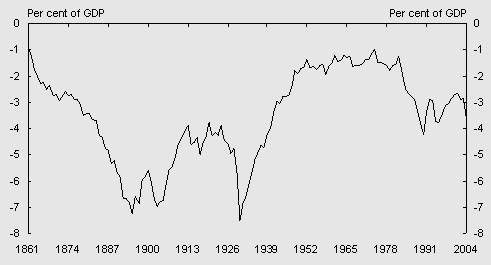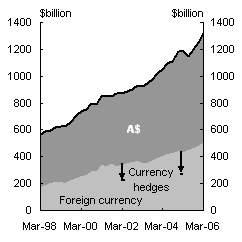Jason Harris and John Hawkins1
Major shifts in the global economy — such as rapid growth in global commodity prices associated with the emergence of China and other countries — are leading to changes in Australia’s international income flows. This is attracting an increasing amount of attention as the net income deficit widens, following a long period of stability.
Higher corporate profits in Australia, notably in the mining sector, are an important cause of the widening in the deficit on international income flows, because a significant proportion of profits accrues to overseas investors. Nevertheless, strong recent investment, especially in the mining sector, will act to lift exports and GDP.
Introduction
Discussion of Australia’s balance of payments usually concentrates on the trade balance — the difference between exports and imports of goods and services.2 However, the deficit on income flows is now about twice the trade deficit. This paper discusses the nature of the net income balance and relates it to Australia’s net international investment position and relevant yields on debt and equity.
Recent movements in the net income balance
Despite being larger than the trade deficit, over the last decade the net income balance has attracted less attention due to its relative stability. It has been the swings in the trade balance which have driven fluctuations in the current account balance (Chart1).3,4
Chart 1: Current account balance as a per cent of GDP

Source: Australian Bureau of Statistics cat. no. 5206.0 and Treasury.
But over the last two years, the net income balance has moved significantly further into deficit, by around 1 per cent of GDP. The budget forecasts that it will stay around this level in 2006-07 (Chart 1). The deficit on the net income balance is large by post-war standards but certainly not unprecedented in the historical record relative to the size of the economy (Box 1).5
|
Box 1: The net income balance in a historical context Australia has had a current account deficit for nine years in every ten since European settlement. Since the current account deficit is equivalent to the gap between national saving and national investment, this historical experience suggests Australia has long had more investment opportunities than it has funded from domestic saving. By running deficits on the current account to exploit these opportunities, Australians have achieved a higher standard of living than otherwise would have been the case. As a consequence of these deficits, Australia has also accumulated a large net international liability position and a corresponding deficit on the net income balance. Chart 2: Net income balance: per cent to GDP 1861 to 2004-05
Source: Derived from Butlin (1987), Lougheed (1987), and ABS cat. no. 5302.0 and 5206.0. |
The majority of the recent increase can be attributed to large increases in mining company profits. The very strong growth in China’s economy is contributing to a significant increase in demand for commodities. This has driven rises in the prices of a wide range of commodities, most notably from an Australian perspective those of coal and iron ore; see Grant, Hawkins and Shaw (2005). Accordingly, revenues of Australian mining companies have risen.
These increased revenues flow through the Australian economy in a number of ways. Wages increase for mining workers and suppliers receive higher prices. The State governments and the Australian Government receive higher tax receipts, through higher royalty payments and company taxes. The companies then pay out some of the after-tax profits to shareholders through dividends (or share buy-backs), and keep some of the profits on their books as undistributed earnings.
As foreign entities own a substantial proportion of these companies, a significant amount of the profits accrue offshore. So far, only a minority of these extra profits have been paid out to foreign shareholders. Table 1 shows that dividends paid overseas increased from $8 billion in 2004 to $10 billion in 2005, whereas the share of profits retained in Australia increased from $13 billion to $17 billion over the same period.
Table 1: Net income balance
|
Credits |
Debits |
Net balance |
||||
|
2004 |
2005 |
2004 |
2005 |
2004 |
2005 |
|
|
$bn |
$bn |
$bn |
$bn |
$bn |
$bn |
|
|
Income on equity |
13.1 |
14.2 |
26.6 |
33.5 |
-13.5 |
-19.2 |
|
Direct investment: dividends and distributed profits |
2.1 |
2.8 |
8.3 |
10.1 |
-6.2 |
-7.3 |
|
Direct investment: reinvested earnings |
9.0 |
9.3 |
13.0 |
17.7 |
-4.0 |
-8.4 |
|
Portfolio income |
2.0 |
2.1 |
5.3 |
5.8 |
-3.3 |
-3.7 |
|
Income on debt |
3.2 |
3.8 |
17.1 |
19.0 |
-13.9 |
-15.2 |
|
Direct investment: income |
0.0 |
-0.1 |
1.7 |
1.4 |
-1.7 |
-1.5 |
|
Portfolio income |
3.2 |
3.9 |
15.4 |
17.6 |
-12.2 |
-13.7 |
|
Other investment income |
1.8 |
2.2 |
2.2 |
3.1 |
-0.4 |
-0.9 |
|
Compensation of employees |
1.1 |
1.2 |
1.7 |
1.8 |
-0.6 |
-0.6 |
|
Total |
19.0 |
21.4 |
47.6 |
57.3 |
-28.6 |
-35.9 |
Source: Australian Bureau of Statistics cat. no. 5302.0, March quarter 2006.
However, even the profits retained within Australia are still often recorded as an income ‘outflow’ in the current account of the balance of payments. This is due to an accounting convention which treats the retained profits as though they had been sent overseas but immediately reinvested back into Australia. The offsetting ‘capital inflow’ is recorded in the financial account of the balance of payments. This convention adopted by the Australian Bureau of Statistics is in line with the international practice as set out in the International Monetary Fund’s Balance of Payments Manual.6
The quantitative importance of this accounting treatment is illustrated by Chart 3, which shows the net income balance as published, and excluding these retained profits. The gap widened substantially in late 2005. However, following large increases in dividend payments in early 2006, the gap has narrowed somewhat.
Chart 3: Net income deficit: as published and excluding retained profits

The components of the net income balance are shown in Table 1. For each type of income flow, the balance of payments records credits (`flows accruing to Australians) and debits (flows accruing to overseas investors). Income flows are broadly classified into those relating to equity (shares) and those relating to debt securities (bonds, notes and money market instruments).7 They are further classified by the type of investment activity from which they arise: ‘direct investment’ (which involves a degree of control) and ‘portfolio investment’ (a more passive investment; see footnote 5).
Explaining movements in the net income balance
Understanding movements in the net income balance requires an examination of its individual components. The discussion in this section shows that, in Australia, the net income balance can be explained in terms of the stock of international assets and liabilities and the key variables which affect rates of return on them — equity yields, interest rates and the exchange rate.
This stands in contrast to the position in the United States. The United States presents an unusual case because, until recently, it apparently had a net income surplus despite having more external liabilities than assets. This implies that the yield earned by United States investors abroad is significantly higher than the yield earned by foreign investors in the United States. Hausmann and Sturzenegger (2005) suggest that United States foreign assets are understated by an amount they term ‘dark matter’, although their analysis has been challenged by Buiter (2006). See Garton (2006) for further discussion of the United States experience.
Income on equity
Australians have increasingly invested overseas to seek higher returns and/or diversify their portfolios. The main destinations (and so the main sources of income) have been the United States, the United Kingdom and New Zealand.
Changes in the income flows Australians receive on their overseas equity investments can be understood by comparing them with other measures of return on equity investments. An implicit average yield on Australia’s equity investments overseas can be derived by dividing the $14.2 billion income flow on equity received in 2005 (from Table1) by the around $400 billion stock of Australian equity investment abroad. The implied yield of around 3 per cent sounds low but it does not include returns in the forms of valuation effects (capital gains) — these accrue to the stock of investment (and so affect the international investment position) but do not appear in the balance of payments (which is a measure of transactions). Reserve Bank of Australia (2006) discusses this issue further.
The Australian Bureau of Statistics data show that price changes added about 8percent to the stock of Australian equity investment abroad during 2005 (and exchange rate changes a further 1 per cent). This suggests a total return for Australian investors of around 12 per cent in 2005, well above the implicit yield of 3 per cent.
Similarly, overseas investors earn income on their equity investmen
ts in Australia. Dividing the $33.5 billion in income paid on equity investment in Australia by the around $470 billion in foreign equity investment in Australia gives a yield of around 7per cent in 2005. In general, the yield foreign investors receive on their investments in Australia moves with measures of the overall yield on Australian assets (Chart 4).
Chart 4: Comparison of yields on foreign equity investment in Australia to earnings yield on Australian shares
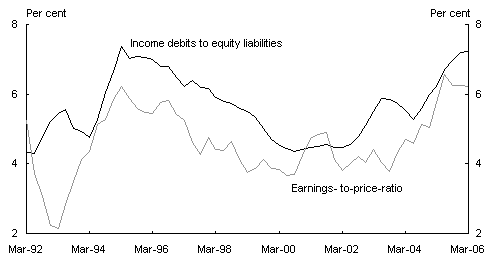
Source: Australian Bureau of Statistics cat. no. 5302.0; Reserve Bank of Australia.
Price changes added a further 6 per cent to this yield for foreign equity investors, bringing their total return (in Australian dollars) in 2005 to around 13 per cent. This is similar to the total return (also expressed in Australian dollars) earned by Australia on its equity investments overseas in the same year.
Over the past decade, the average rate of return on Australian holdings of foreign equities has been similar to the average annual rate of return of foreign holdings of Australian equities of around 8-9 per cent (Chart 5). Returns on overseas equities were particularly strong around 2000, and weak thereafter, due to the ‘dot com’ boom.
Chart 5: Comparison between returns on Australian and foreign equity
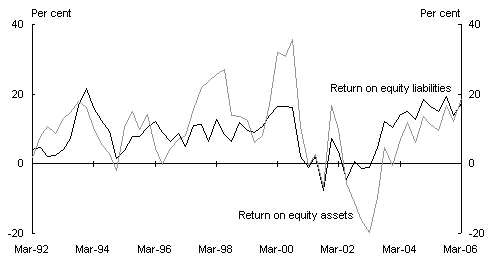
Source: Australian Bureau of Statistics cat. no. 5302.0.
Income on debt
Australians earn interest on their holdings of foreign bonds and notes. Dividing the $3.8 billion of portfolio income in 2005 by the around $70 billion of these securities held implies an average yield of around 5 per cent. Around a third of the securities are denominated in Australian dollars, around another third in US dollars and the remainder in various other currencies, of which the most important are the euro, sterling and yen. About half have a remaining maturity of under three months.8
Chart 6 compares the implied yield with a representative interest rate of 12-month bonds. Both have tended to come down over the past decade as lower inflation has become firmly established both in Australia and major overseas economies. The recent rise in global bond yields should gradually be reflected in increased average yields earned by Australian investors as old bonds mature and are replaced by those with higher yields.
Chart 6: Implied yield on Australian holdings of foreign debt assets and a weighted average of 12-month bond yields
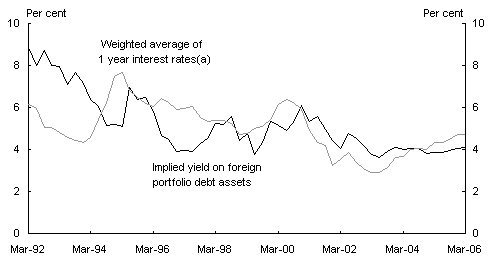
- Weighted according to approximate currency denomination of foreign debt assets.
Source: Australian Bureau of Statistics cat. no. 5302.0.
Australian entities have issued more debt securities overseas than they have purchased. Most of the securities have been issued by the banks. Battellino (2002) observes that individual issues of offshore debt securities tend to be larger than domestic issues and the average credit quality is lower. Dividing the $19 billion of income paid out in 2005 by the around $440 billion of foreign debt securities on issue gives an average yield of around 4 per cent. Chart 7 shows the implied average yield follows the representative interest rates on 12-month bonds. It is therefore likely to rise over coming quarters, tending to widen the net income deficit.
Chart 7: Implied yield on Australia’s foreign debt liabilities and a weighted average of 12-month bond yields
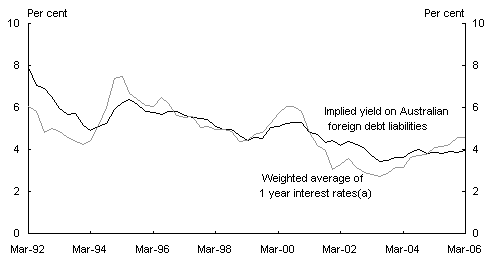
- Weighted according to currency denomination of foreign debt liabilities.
Source: Australian Bureau of Statistics cat. no. 5302.0.
Exchange rate effects
As the value of Australia’s foreign liabilities is significantly higher than the value of its foreign assets, one might expect a depreciation of the exchange rate to increase the value of Australia’s net foreign liability position. This would also increase the Australian dollar value of payments to foreigners, resulting in an increase in the net income deficit.
Many developing countries have been vulnerable to large depreciations of their currency, because their foreign debt is entirely denominated in foreign currency. The inability to issue offshore in the domestic currency, termed ‘original sin’ by Eichengreen and Hausmann (1999), risks a vicious cycle of currency depreciations worsening the net income balance and leading to further depreciation.
However, because of the currency composition of foreign assets and liabilities, this is not the case in Australia. Almost 40 per cent of the debt securities issued by Australian entities are denominated in Australian dollars. About a third is denominated in USdollars with the remaining quarter spread among various other currencies, of which the most important are the euro, pound sterling and yen. In addition, all of Australia’s equity liabilities are denominated in Australian dollars.
The vast majority of Australia’s foreign assets are denominated in foreign currency. So despite the fact that Australia’s external liabilities exceed external assets, foreign currency liabilities are actually less than foreign currency assets. In addition much of Australia’s foreign currency exposure is hedged by financial instruments (see Box 2), further increasing Australia’s ‘long’ position on foreign currency (Chart 8). (In the balance of payments, the net income balance is based on the original denomination of the borrowing with offsetting derivative positions being reflected in the financial account. Hedging does not affect the net income balance.)
This implies that a currency depreciation would lead to a larger rise in the value of foreign currency assets than foreign currency liabilities. The initial impact of a depreciation would probably therefore be to reduce Australia’s net external liabilities, in contrast to countries that have faced economic crises, and to Australia’s position in the mid-1980s. It would probably also reduce Australia’s net income deficit.
Interest rate effects
The value of both income receipts on debt assets and income payments on debt liabilities will vary with movements in interest rates. As Australia’s debt liabilities exceed debt assets, the net effect of an increase in interest rates will be to widen the net income deficit.9
The accounting treatment implies that an increase in overseas interest rates will affect the net income balance even if Australian borrowers are all fully hedged. In this case the borrowers will effectively pay Australian interest rates but the balance of payments will record the payments based on international interest rates with the offsetting hedge being reflected in valuation effects. See Reserve Bank of Australia (2006) for a further discussion.
|
Box 2: Hedging Australia’s Since the floating of the exchange rate in 1983, Australian companies that trade with the rest of the world have been subject to more exchange rate risk. And the deregulation of the financial markets over the 1980s increasingly allowed firms to borrow and lend in foreign currency, further increasing foreign currency exposure. Many companies are naturally hedged due to their revenue streams. For example, a company may have borrowed in yen to develop a mine but have presold the ore to a Japanese company at a set price also in yen. If the Australian dollar depreciates, the company faces higher interest costs (increasing the net income deficit) but this is offset by higher revenues from its exports (decreasing the trade deficit). Furthermore, many Australian borrowers have hedged their exposure using financial derivatives such as swaps, futures and options. The ABS has twice collected data on this hedging activity, in June 2001 and March 2005; see ABS (2001, 2005) and the discussion in Reserve Bank of Australia (2002, 2005, 2006). The surveys show that Australian borrowers in the financial sector hedged 93 per cent of their foreign currency debt in 2001 and 85 per cent in 2005. Other borrowers used financial instruments to hedge 38 per cent of their foreign currency debt in 2001 and 46 per cent in 2005. Financial hedges may not cover the full term of the underlying debt exposure, as derivatives markets become thinner at longer maturities. The net effect of the bought ($1.8 trillion) and sold ($1.7 trillion) derivative contract values was a hedging of $122 billion of Australia’s foreign currency exposure in March 2005. Combining this with the fact that Australia holds more foreign currency assets than liabilities ($140 billion), the economy has an even larger long foreign currency position, about $260 billion in March 2005. It had a similar position in June 2001 (as illustrated by the arrows in Chart 8). |
|
Chart 8: Exchange rate exposure |
|
|
Assets |
Liabilities |
|
|
|
Source: Australian Bureau of Statistics cat. no. 5302.0.
Concluding remarks
Net income flows often provide a partial offset to movements in the trade balance. For example, they tend to subtract more from the current account balance when export prices boom, but subtract less should export prices ease back. The net income balance is related to the net international liabilities cumulating from successive current account deficits. It also reflects the rates of return earned by Australians on equity investments abroad and by foreigners on equity investments in Australia; although over the longer run these rates of return tend to be similar.
The exceptionally strong levels of business investment in recent years, particularly in the mining sector, are likely to generate further mining export sales and increased profits for many years. While this will act to narrow the trade deficit, it will likely act to widen Australia’s net income deficit in the next few years. On the other hand, commodity prices could at some stage decline, which would tend to widen the trade deficit but narrow the net income deficit.
While in many ways today’s net income deficit is a reflection of strong profitability in Australia rather than any weakness, it is appropriate to monitor it and particularly to understand the causes of any movements.
References
Australian Bureau of Statistics 2001, ‘Measuring Australia’s foreign currency exposure’, Balance of payments and international investment position, cat. no. 5302.0, December quarter, pp 11-16.
Australian Bureau of Statistics 2005, Foreign currency exposure, cat. no. 5308.0, released 22 November.
Battellino, R 2002, ‘Why do so many Australia borrowers issue bonds offshore?’, Reserve Bank of Australia Bulletin, December, pp 19-24.
Buiter, W 2006, ‘Dark matter or cold fusion?’, Goldman Sachs Global Economics Paper, no.136, January.
Butlin, N 1987, ‘Australian National Accounts’ in Vamplew, W (ed) Australians: Historical Statistics, Fairfax, Syme & Weldon, Sydney.
Eichengreen, B and Hausmann, R 1999, ‘Exchange rates and financial fragility’, in New Challenges for Monetary Policy , Federal Reserve Bank of Kansas City, pp 329-68.
Garton, P 2006, ‘Valuation effects, the rate of return differential and US external sustainability’, Treasury working paper, forthcoming.
Grant, A, Hawkins, J and Shaw, L 2005, ‘Mining and commodities exports’, Economic Roundup, Spring 2005, Treasury, pp 1-15.
Hausmann, R and Sturzenegger, F 2005, ‘U.S. and global imbalances: can dark matter prevent a big bang?’ Kennedy School of Government.
Lougheed, A 1987, ‘International transactions and foreign commerce’ in Vamplew, W (ed) Australians: Historical Statistics, Fairfax, Syme & Weldon, Sydney.
Pulsford, E 1892, Notes on Capital and Finance in Australasia, Edward Dunlop & Co, Sydney. Reprinted from articles in the Sydney Morning Herald June 1892.
Reserve Bank of Australia 2002, ‘Australia’s foreign currency exposure and hedging practices’, Reserve Bank of Australia Bulletin, August, pp 56-60.
Reserve Bank of Australia 2005, ‘Australia’s foreign currency exposure and hedging practices’, Reserve Bank of Australia Bulletin, December, pp 1-7.
Reserve Bank of Australia 2006, ‘The growth in Australia’s foreign assets and liabilities’, Reserve Bank of Australia Bulletin, April, pp 1- 8.
1 The authors are from Domestic Economy Division in the Australian Treasury. This article has benefited from comments and suggestions provided by Laurie Brown, Phil Garton, MichaelHarvey, Steven Kennedy, Paul Mahoney, Martin Parkinson, Wendy Raedt and Lachlan Shaw. George Stanwix created the charts. The views in this article are those of the authors and not necessarily those of the Australian Treasury.
2 Imports of goods are discussed in the Economic Roundup, Summer 2004-05, and resource exports in the Spring 2005 issue. Manufactures and services exports are the subject of submissions to parliamentary inquiries included in this issue of the Economic Roundup. Speeches on the current account and the terms of trade are in the Summer 2006 issue. The net income balance was previously discussed in the 2001 Centenary issue.
3 There is a third component of the current account balance: ‘net transfers’. These include, for example, the Government’s foreign aid programme and the donations made by Australians to tsunami victims. Net transfers are fairly stable and are less than 0.1 per cent of GDP.
4 This article was completed prior to the release of the June quarter 2006 Balance of Payments.
5 Arguably the first writer to estimate Australia’s net income balance, and express concern about the size of the deficit, was fervent free trader and future senator Edward Pulsford (1892). The deficit
was then much larger relative to the size of the economy (Chart 2).
6 To be more precise, how the undistributed earnings affect the net income balance depends on the degree of direct foreign ownership. For companies with direct foreign ownership of at least 10 per cent, a corresponding proportion of the undistributed earnings will be recorded as an outflow of income which is immediately reinvested in Australia. For an Australian company in which individual foreign entities own small stakes, a proportion of dividends (but not retained earnings) are included in ‘portfolio investment income debits’.
7 There are two smaller categories of income: ‘other investment income’, and ‘compensation of employees’. The former consists mainly of non-tradable loans by and deposits with banks, and trade credit provided by companies to their customers. The latter refers to income earned by expatriate workers on short-term assignments. An Australian working in a bar in London would contribute an income credit while a foreigner picking fruit in the Riverina would contribute an income debit.
8 Securities are classified by the time remaining to maturity, not the original maturity when issued. Hence a 10-year bond due to mature in less than a year is recorded as a short-term liability.
9 This is the initial impact. Beyond that, interest rate movements will affect Australia’s demand for imports and the world’s demand for our exports, altering the trade deficit; and the exchange rate may respond to changes in relative interest rates. The resultant impact on the current account will affect the stock of foreign debt liabilities and hence the net income balance.
